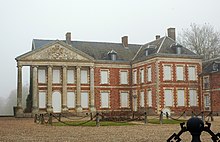| Revision as of 17:33, 4 December 2016 editMccapra (talk | contribs)Autopatrolled, Extended confirmed users, Page movers, New page reviewers170,043 edits →Career← Previous edit | Revision as of 17:34, 4 December 2016 edit undoMccapra (talk | contribs)Autopatrolled, Extended confirmed users, Page movers, New page reviewers170,043 edits →CareerNext edit → | ||
| Line 43: | Line 43: | ||
| He was in the ] of the ] (future ] ]), and became an officer in a ] regiment.<ref>Chronicle of the French Revolution, Longman 1989 p.35</ref> He served in the ],<ref name="dictionary">{{cite book|last1=Scott|first1=Samuel|last2=Rothaus|first2=Barry|title=Historical Dictionary of the French Revolution 1789-1799|url=https://www.questia.com/read/71902167/historical-dictionary-of-the-french-revolution-1789-1799|accessdate=6 April 2015|volume=2|year=1985|publisher=Greenwood Press|location=Westport|subscription=yes|via=]}}</ref> and was a hero of the ] in 1781.<ref>Chronicle of the French Revolution, Longman 1989 p.35</ref> | He was in the ] of the ] (future ] ]), and became an officer in a ] regiment.<ref>Chronicle of the French Revolution, Longman 1989 p.35</ref> He served in the ],<ref name="dictionary">{{cite book|last1=Scott|first1=Samuel|last2=Rothaus|first2=Barry|title=Historical Dictionary of the French Revolution 1789-1799|url=https://www.questia.com/read/71902167/historical-dictionary-of-the-french-revolution-1789-1799|accessdate=6 April 2015|volume=2|year=1985|publisher=Greenwood Press|location=Westport|subscription=yes|via=]}}</ref> and was a hero of the ] in 1781.<ref>Chronicle of the French Revolution, Longman 1989 p.35</ref> | ||
| He was a founding member of the ] in 1788.<ref name="larousse"/> | Although he married a rich heiress from ], He was a founding member of the ] in 1788.<ref name="larousse"/> | ||
| He was deputy to the ],<ref name=dictionary/> which subsequently became the ] and ]. As the Assembly began to divide into factions, Lameth, a ], was identified with the ].<ref name="larousse"/> Since the ] moved toward a ], he ] to ].<ref name="larousse"/> | He was deputy to the ],<ref name=dictionary/> which subsequently became the ] and ]. As the Assembly began to divide into factions, Lameth, a ], was identified with the ].<ref name="larousse"/> Since the ] moved toward a ], he ] to ].<ref name="larousse"/> | ||
Revision as of 17:34, 4 December 2016
| Charles Malo François Lameth | |
|---|---|
 Lameth caricatured by Honoré Daumier, 1832 Lameth caricatured by Honoré Daumier, 1832 | |
| Born | 5 October 1757 – 28 December 1832 Paris, France |
| Died | 28 December 1832 |
| Spouse | Marie Anne Picot |
| Parent(s) | Louis Charles de Lameth Marie Thérèse de Broglie |
| Relatives | Alexandre-Théodore-Victor, comte de Lameth (brother) Théodore de Lameth (brother) |
Charles Malo François Lameth (5 October 1757 – 28 December 1832) was a French politician and soldier.
Early life
Charles Malo François Lameth was born on 5 October 1757 in Paris. His father was Louise Charles de Lameth and his mother, Marie Thérèse de Broglie. His mother was the sister of the Marshall de Broglie and a favourite of Marie Antoinette.
Career
He was in the retinue of the comte d'Artois (future King Charles X), and became an officer in a cuirassier regiment. He served in the American War of Independence, and was a hero of the Battle of Yorktown in 1781.
Although he married a rich heiress from Saint Domingue, He was a founding member of the Society of the Friends of the Blacks in 1788.
He was deputy to the Estates-General of 1789, which subsequently became the National Assembly and National Constituent Assembly. As the Assembly began to divide into factions, Lameth, a constitutional monarchist, was identified with the Feuillants. Since the French Revolution moved toward a Republic, he emigrated to Hamburg.
He returned to France under the Consulate, and was appointed governor of Würzburg (in the Duchy of Würzburg) under the First Empire. In 1814, he rose to the rank of Lieutenant General. Like his brother Alexandre Lameth (but unlike his other one, Théodore de Lameth), Charles joined the Bourbon camp after the Restoration, succeeding Alexandre as deputy in 1829. In the final years of his life, he was nonetheless a noted supporter of the July Monarchy.
Personal life

He married Marie Anne Picot. They had two children. They resided at the Château d'Hénencourt in Hénencourt, Somme.
Death
He died on 28 December 1832.
References
- ^ Lameth (Charles Malo François, comte de), Histoire de France, Paris: Larousse, 2005.
- ^ , GeneaNet
- Chronicle of the French Revolution, Longman 1989 p.35
- Chronicle of the French Revolution, Longman 1989 p.35
- ^ Scott, Samuel; Rothaus, Barry (1985). Historical Dictionary of the French Revolution 1789-1799. Vol. 2. Westport: Greenwood Press. Retrieved 6 April 2015 – via Questia.
{{cite book}}: Unknown parameter|subscription=ignored (|url-access=suggested) (help) - Chronicle of the French Revolution, Longman 1989 p.35
- French Ministry of Culture: Château d'Hénencourt